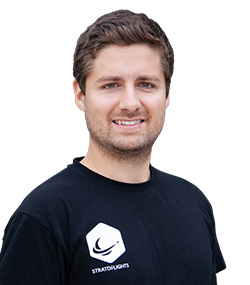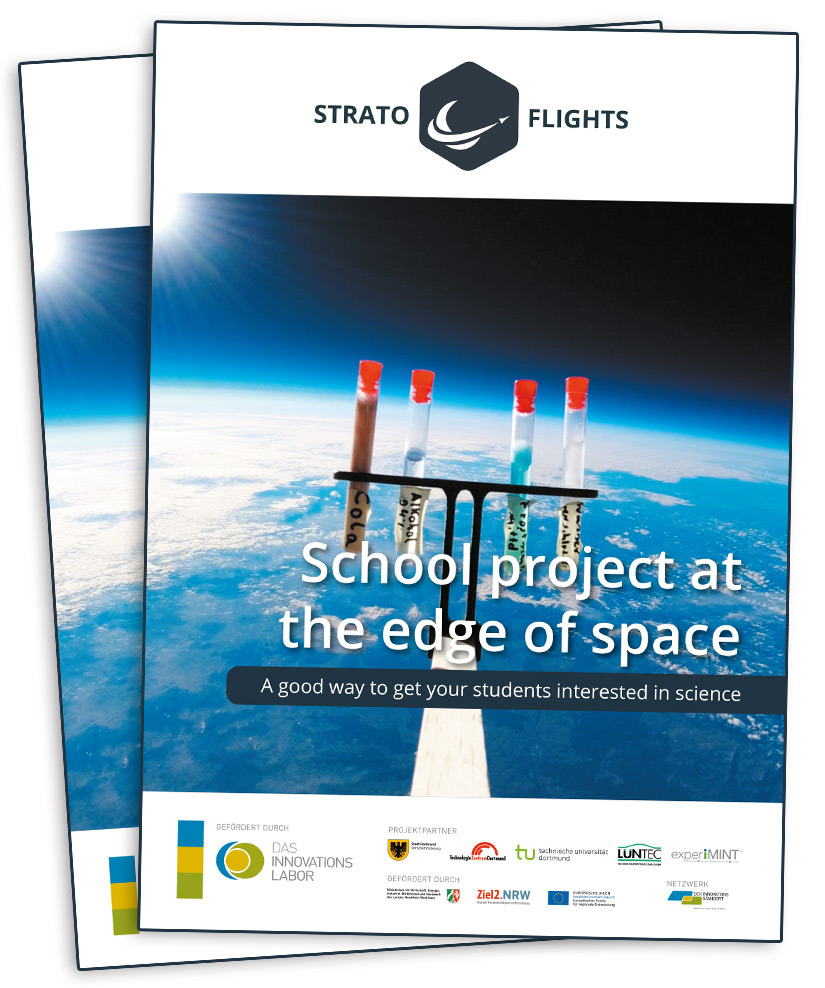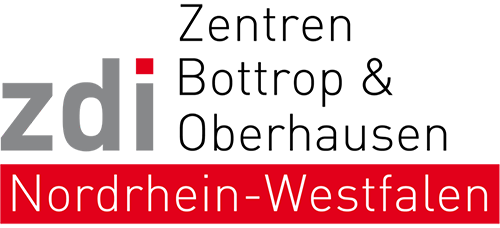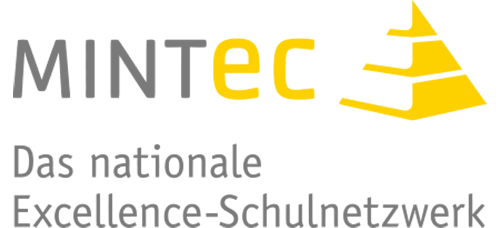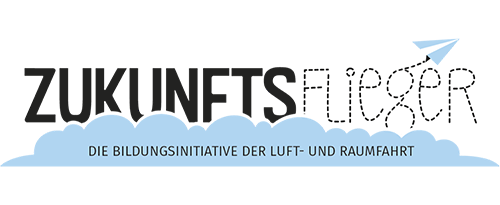Exemplary Schedule for a STEM-School project week at the edge of space
A stratosphere flight is a very scalable project in terms of the duration and its content. Thus, the classroom on the edge of the universe can be easily adapted to suit students from the fifth up to thirteenth grade and beyond, like in vocational schools and universities. The following exemplary schedule will provide you with an overview, for a complete project week of 4 to 5 days. And it’s up to you, if you want to spread the project over the whole school year, or if you wish to concentrate it in one project week.
Furthermore, different science courses can be fitted in this project, for example, the biology course develops an experiment, while the physicists worry about the perfect construction of the probe to face the extreme conditions of the stratosphere. The computer scientists will program the data logger to record the measurement data throughout the stratosphere.
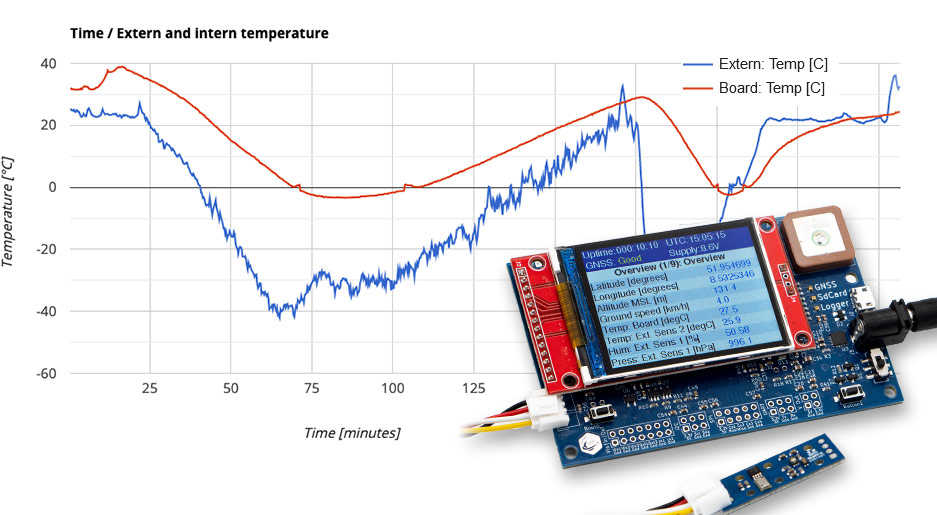
1: Introduction (Duration: 1 day)
| Key questions/tasks |
Methodology / Media |
- Our main goal is it, to send a weather balloon with a camera and sensors to the stratosphere. What do we need?
- What challenges arise and what is the best way to solve them?
- What types of risk may arise?
- Which materials are suitable for the mission?
- What are the requirements for the probe and how will it look like? Design your own probe on paper (probe, parachute, balloon, camera)
- Which gas will we use for the weather balloon and why?
- How does the weather balloon create the uplift? Groupwork: approx. 30 minutes. Show the simple math video (Archimedes Principle)
- From which layers does the earth’s atmosphere consist? In what heights are these? (Comparison with the highest mountain in Germany, highest mountain in the world, the altitude of an Airbus A380, weather balloon, where does space begin?)
|
- Show pictures from the stratosphere, then Think-Pair-Share:
- (1) SuS note their thoughts on cards
- (2) SuS talk about their findings, with a partner
- (3) Every question/ problem areis collected and sorted on a board/pinboard
- Presentation of the results including a Q&A session
- Group work with the focus on:
- (1) Construction of the probe
- (2) Technology (camera, battery pack, GPS)
- (3) Data Logger
- (4) Experiment
- (5) Marketing / Video
- “Welt der Wunder” article (About Stratoflights)
- Weather balloon registration via our tool (Please note, the real approval must be obtained 2 to 4 weeks before the launch)
- Check the weather for your flight date
- Predict your flight route with our tool
- The marketing team can document every step with the camera and create a video for the final presentation
|
2: Project preparation (Duration: 1-2 days)
| Key questions/tasks |
Methodology / Media |
- Conception and construction of the probe
- Test measurements of the data logger
- How can the measured data be evaluated? (for example, in Excel, via Google Earth, or via Stratoflights tools)
- GPS-Test: how does a satellite tracker work in practice?
- What is the take-off weight of the probe?
- What is the amount of helium which is needed for the ascent?
|
- Students work in small groups on their respective work assignments, document their work progress and keep close contact with the other groups
- Show the Stratoflights weather balloon tutorial
- Provide building material and tools
- Place an experiment or an object in front of the camera (for example, thermometer, the school mascot, sponsor logo, class photo)
- Stratoslfights tools for measurement data evaluation
- Instructions and tutorials from Stratoflights
- Guides and tutorials from the Stratosflights advertising to promote your own school for a call to observe the stratosphere flight
|
3: Start of the weather balloon (Duration: 1 day)
| Key questions/tasks |
Methodology / Media |
- Completion and final control of the probe
- Test of the complete equipment
- Check the required amount of helium
- Start of the weather balloon
- Locate the weather balloon, plus the probe and recover them
|
- Create a group (eg. WhatsApp) to keep everyone updated to the salvage
- Update the flight forecast
- Flight assistants fill the balloon with helium
- Carpooling (if necessary after school with the parents for the salvage)
|
4: Evaluation of the measured data and presentation (Duration: 1-2 days)
| Key questions/tasks |
Methodology / Media |
- How was the salvage?
- Which measurement data did we record?
- How can we interpret the information? Why does the temperature drop as altitude increases, but does it eventually increase again and will it reach plus degrees again?
- What effect has the ozone layer on the temperature profile and why?
- Why is the air pressure decreasing during the ascent? Is there a proportional pattern or not? And if there is what is the answer to it?
- Editing a video documentation
- What did the learning experiences we make during this project? Are we satisfied with the results?
- What worked well/ not so well during the group parts? What would you do differently the next time?
- Documentation as a guideline for the next year
|
- Sighting of the video recordings
- Evaluation of the measured data in Excel
- Evaluation of the measured data in the Stratoflight tool for Google Earth
- Creation of posters/ PowerPoint presentations:
- (1) Which different atmospheric layers exist?
- (2) Why is helium providing an uplift?
- (3) What equipment is needed for a mission to space?
- (4) How does the location software work? (GPS tracker, flight route prediction)
- (5) How should the probe be constructed? With which material?
- (6) What are the general challenges and difficulties of this project?
- (7) Why does the weather balloon burst in the stratosphere?
- (8) What insights can we draw from the data logger’s data stream?
|
Advantages of the project:
- Extraordinary learning experience for students with an adventure character, to awaken curiosity and enthusiasm for science.
- Interdisciplinary: Combination of different STEM subjects
- Combination of theory and practice:
- Clear objectives and tasks with a strong practical relevance
- Usage of technically as well as organizationally and methodically skills
- Teaching material is available from “Klett”, e.g. about weather and the greenhouse effect or the ozone hole
- Support with various media products: graphics, worksheets, scientific reports, data sheets, computer research, and presentations
- Connection to the curriculum can be generated
- Marketing effect for your school and for the STEM subjects in general
Depending on the level of knowledge of the class and the interests of the students, the topics dealt with can be adapted from project to project.
The teaching suggestions are intended to provide an orientation on various STEM subjects that can be adapted to the curriculum and educational standards.
The most beautiful aspect of such a stratosphere flight is that the project is very thrilling and an excellent learning platform for science subjects. Additionally, the project will encourage your students to demonstrate their skills and show them new learning opportunities.
» These school already took advantage «
If you are looking for exciting school project ideas, a stratosphere flight provides the ideal setting for a variety of experiments and learning objectives.
Look at our gallery to find out, who has already taken the opportunity to take their classroom up to space.







 Deutsch
Deutsch  Français
Français  Español
Español 